#hws thessaloniki
Text
Big inspiration from @allbeendonebefore. The designs for Athens and Thessaloniki were based from her work!
Recently, I came across a post from the talented @margaretartstuff, which inspired me to do my own take of the "myth of the mermaid".

The human is Thessalonikia (that's how Thessaloniki was called in ancient times) and she converses with the person whom she was named after, Thessaloniki.
I don't know how popular this myth is outside of Greece, but I still wanna share it due to how tragic it is. It goes that when Princess Thessaloniki, Alexander the Great's half-sister, learnt about her brother's death, she jumped from a cliff to drown. She didn't die, but instead, she turned into a mermaid. Ever since that day, she stops every ship passing by and asks "Is Alexander the Great alive?". The captain must answer "He lives, and he reigns, and he conquers the world" if he wants to keep sailing safely, or else, the mermaid will send a fierce storm to crash his ship. This dialogue is depicted above. So, if you ever find yourself in Greece and a mermaid asks you about Alexander the Great, you know what you should answer. ;)
#greece#Alexander the Great#greek history#greek myths#thessaloniki#thessalonikia#athens and sparta adventures#athens and thessaloniki adventures#aasa#aata#aph thessaloniki#hws thessaloniki
17 notes
·
View notes
Text
Big inspiration from @allbeendonebefore. The designs for Thessaloniki were based from her work!
As I was scrolling Tumblr today, I stumbled across this lovely pair of earrings from the Byzantine period.
I immediately recalled Thessaloniki, thinking that these earrings would fit her extravagant style and I drew her wearing them. Plus, she was an important centre in the Byzantine Empire, so it makes sense she would wear them. Here she is!
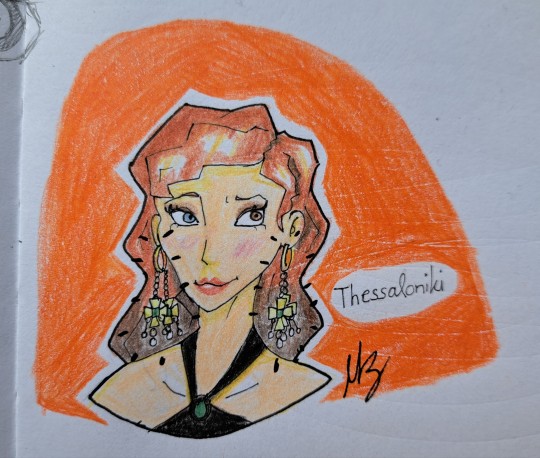
And here are the so-called earrings.

#aph: thessaloniki#hws thessaloniki#thessaloniki#athens and sparta adventures#athens and thessaloniki adventures#aasa thessaloniki#aasa#aata
9 notes
·
View notes
Text
Big inspiration from @allbeendonebefore. The designs for Athens and Thessaloniki were based from her work!
For whatever reason, I was inspired to draw a pretty rushed (as you probably can see) piece about Athens and Thessalonikia's (because this is how she was called in ancient times) first meeting.

Athens looks at her like this because that's the first time he sees her after she was born/founded (don't know how that works in Hapo's universe) wonders if she will ever amount to anything (spoiler alert: she does) and doesn't know yet that she's gonna be his biggest rival (and his biggest headache) for the next 2.400 years.
Thessaloniki looks at him like this, because she doesn't know he's an asshole yet (and also because she doesn't blame him yet for everything going wrong with her city).
That reminds me that I should make a post about Thessaloniki's founding story.
See you soon 😊!
#athens and sparta adventures#athens and thessaloniki adventures#aasa#aata#aasa athens#aasa thessaloniki#hws athens#hws thessaloniki#aph: thessaloniki#aph: athens
5 notes
·
View notes
Text
Big inspiration from @allbeendonebefore. The designs for Athens was based from her work!

Here we have Athens in PASOK merchandise. The idea came to me after a discussion with myself:
My brain: Hey, remember Hapo's Athens?
Me: Yes?
My brain: What's his theme color?
Me: Green.
My brain: And what else is green?
Me: PASOOOOOK!
For those of you wondering, PASOK (Panhellenic Socialist Movement) was an influencing social-democratic political party during the '80s and '90s.
Most adults who grew up during that time period remember it as a "Golden Age", where the country met positive development (not just the big cities, like Athens and Thessaloniki, but small villages as well) and "even homeless people had a home to stay" etc.
But all good things must come to an end. The reason behind this development was mainly because we were borrowing money from other European countries and after a time, we had to pay them back. The problem was that we wasted that money on entertainment mostly and not on profitable activities, like business, trade, industry etc. That's one of the many reasons why we met the financial crisis at the end of the first decade of 2000. Actually, the reasons are much more complicated, but I am not an expert to discuss them, so I recommend you to check them out yourselves.
There's also a term named after it, called Pasokification, which refers to the decline of centre-left social-democratic political parties in European and other Western countries during the 2010s, often accompanied by the rise of nationalist, left-wing and right-wing populist alternatives.
I imagine that Athens (and the rest of Greece) still have their PASOK merchandise and wait for it to retrieve its power...
#athens and sparta adventures#athens and thessaloniki adventures#aasa#aata#aasa athens#hws athens#pasok#pasokification
4 notes
·
View notes
Text
Note: The characters presented there are inspired by @allbeendonebefore's work and they have no intention to mock you, rather to entertain you.
Hello again. In my previous post, I talked about the regional unit of Aetolia-Acarnania. Here, I'm gonna present some of its important cities. Starting with the capital itself…

Artistic choices: As with Aetolia and Acarnania in the previous post, I based her design from one of my aunts. Specifically, I made her tall with brown hair. I originally intended her to have scars all over her body, from the three Sieges (that we are going to talk about later) that took place in her city, but I ended up finding this idea over-the-top and she has fair skin. She is famous as a fish farming site, so I gave her clothes that make it easy for her to access waterz like boots, shorts and a plain t-shirt.
Messolonghi (as I prefer to call her) is the capital of Aetolia-Acarnania, despite not being its biggest city (Agrinio holds this position). Think of it like Edmonton and Calgary's case in Alberta, Canada.
It's one of these greek towns that has associated itself with the Greek War of Independence, a War that lasted from 1821 to 1829, and ended with the Greeks receiving their freedom from the Ottoman Empire.
To name, during that war, three dramatic sieges took place there. The first two (in 1822 and 1823) were unsuccessful, but the third was devastated for the Messolonghians.
Let's start from the beginning. Messolonghi is a city protected by a chain of small islands and its lagoon from the sea, and by a wall and the marshy terrain from the landward side. Additionally, it emerged as a fishing and trading settlement. All these made her a place in a vital position and that's why the Ottomans attacked her.
The reason the first two sieges were unsuccessful was due to the fact that the Ottomans focused solely on cutting connections and food from the land and thanks to the town's history as as a fishing and trading settlement, the residents could supply themselves via the sea route.
On the third time, however, the Ottomans came with a much stronger navy, cutting connections from both the land and the sea. The siege lasted till the spring of 1826. The Greeks had grown devastated and weak after a long and suffering winter without supplies, even going as far as to eat dogs, cats and mice from the streets. The residents looked skeletal and you could see corpses on the ground.
It was then that the Messolonghians decided to burst out of the gates and attempt to lead the women and children to safety. Meanwhile, those who were dying and/or too sick were piled into houses packed full of gunpowder to blow themselves up when the Ottomans arrived to kill them.
On the night of 10 April, the Greeks realised their plan, having to face an army of Ottomans who were informed about their escape. 10,000 emerged. Only 1,000 Greeks made it alive.
It's one of the most popular and important event of the Greek War of Independence, as it moved thousands of Philhellenes across the globe, who came to support the Greeks and it inspired works of art, like "The Free Besieged", a poem written by our national poet, Dionysios Solomos.
Here's an unofficial English translation I found on the Internet:
A silence as prevalent as death reigns over the plains
a bird speaks, takes a seed, and the mother envies it.
The famine blackened the eyes. The mother is swearing onto the eyes.
The good soldier from Souli stands aside and cries:
"Lone dark rifle, why do I hold you in the arm,
for you are a burden to me and even the Muslim knows ?"
April and Eros are dancing and laughing together,
and as many blossoms and cores come out, so many weapons enclose you.
A small white hill of sheep yells in movement,
and gets thrown deep within the sea again,
and merges its vast whiteness with the beauties of the sky.
And into the waters of the lake, which it reached in fast,
a blue butterfly played with its shadow,
that felt its sleep within the wild Fleur-de-lys.
The petite worm is also coming on its age.
The nature is magic and a dream in beauty and grace,
the black stone and the dried up grass are vast golden.
It spills itself with a thousand faucets, it speaks on a thousand languages:
"Whoever dies today will perish a thousand times."
The theme of the poem is about temptation and it's easily obvious on the last lines, where beautiful euphemisms are used to describe nature. One could ask "Who would want to die in such a beautiful day?". But as history (or to be more precise, this episode) showed, the Greeks preferred death over becoming slaves of the Ottomans.

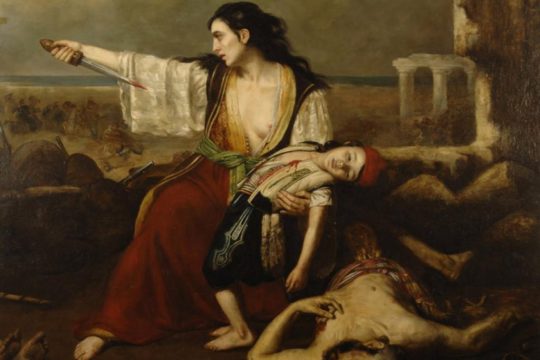
In this drawing, you can see a mother about to commit suicide after having killed her kid (which is seen lying in her left arm), in an attempt not to end in the arms of the Ottomans.

The Garden of Heroes, a place dedicated to important military and political figures of the city, particularly from the Greek War of Independence.
Oh, I forgot to say that Lord Byron, a famous English poet and Philhellene died there.
Honestly, I feel like I talked too much about the Greek War of Independence…
On an unrelated note, she's in a rivalry with Agrinio, the biggest city and Economic Centre of Aetolia-Acarnania, but we will discuss it later (honestly, if you're following me for a while or if you've read my #athens and thessaloniki adventures posts, you will have noticed that we Greeks don't exactly get along)…

Artistic choices: I based her body type and hair from my mom, as she grew up in a small village near Agrinio. My mom doesn't smoke, but I made her a smoker, since, as I stated in the fun fact above, Agrinio is known across Greece for its tobacco production. My mom has participated in this when she was a little girl and she has a lot to tell me about it… Plus, she isn't redhead, she's actually brunette, she just likes to dye her hair red (just like my mom).
Enjoy a video depicting the production of tobacco. My mom showed it to me and said its pretty accurate to what she did when she was little.
https://youtu.be/E-F_iOQ88Ds
Agrinio is the biggest city of the regional unit of Aetolia-Acarnania and its Economic Centre. It's not the capital however. It's a similar case like the one with Edmonton and Calgary in Alberta, Canada.
It has acquired one of the worst reputations among greek cities, as a city that you "should avoid at all costs" and its residents as people you "should avoid at all costs". Here, I'm going to dissolve this ugly reputation or at the very least, try to justify it.
Agriniots in general are seen as "savages" that speak terribly greek. The reason for this is because, unbestknown for the majority of non-Agriniots, the people who claim to be from Agrinio aren't from Agrinio. They're from nearby villages, they just say Agrinio to help the listener locate the place. And because villagers have this reputation as being uncivilised and because every village speaks with a different accent, Agriniots earned the aforementioned reputation.
They're also in a rivalry with Messolonghi. The best way I can describe it is like this:
Agrinio: I'm the biggest city and Economic Centre of this regional unit! Why is SHE the capital?!
Messolonghi: I deserve this title because I'm an historic city!
Etc, etc

Artistic choices: He's a lobster, because his name "Astakos" in Greece means lobster and I thought it was funny. However, I don't know how he got that name. I searched information online and I didn't find anything about Astakos being famous for his lobster farming.
Nothing to say, except that it's a nice village to stroll and have dinner if you ever find yourself in Greece. Plus, I liked this building when I visited it.

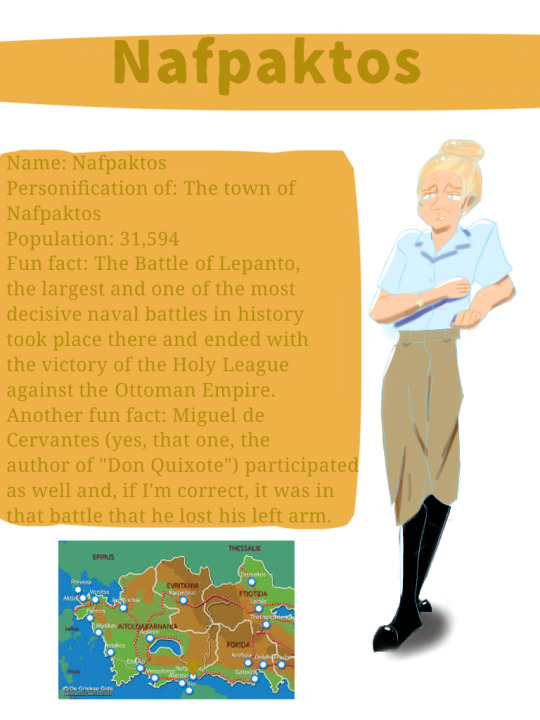
Artistic choices: When most foreigners think about us Greeks, they think of slightly tanned people with brown or black hair. This is to a great extent true. For this reason, I wanted to create a character that looked less "Greek" and more "foreigner" just for the fun of it. She would be woman, have blonde hair (for the record, there're Greeks who have blonde hair, but there're huge brown hues on it. I wanted her hair to be pure blonde) and blue eyes. And that's how Nafpaktos came to be!
During the time she was under the Venetian Republic, she was named Lepanto. It's also the place where the Battle of Lepanto happened. You probably have heard it at least one in your life, as it's one of the most famous naval battles, and if you're Spaniard, it rings a bell in your ear.
It's considered of vital importance to the Europeans, since it marked the turning-point of Ottoman military expansion into the Mediterranean. Miguel de Cervantes, whom you might know as the author of Don Quixote, participated, where he severely injured his arm. In fact, there's a statue of him lifting his right arm, the arm which he used to write several famous literature works.
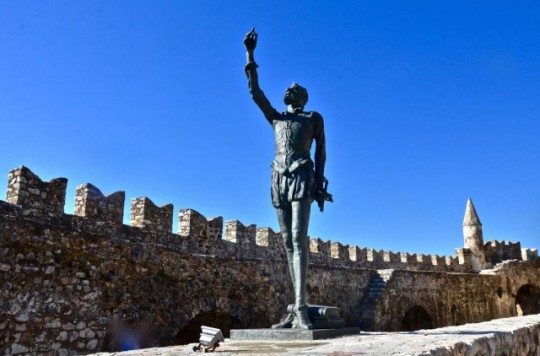
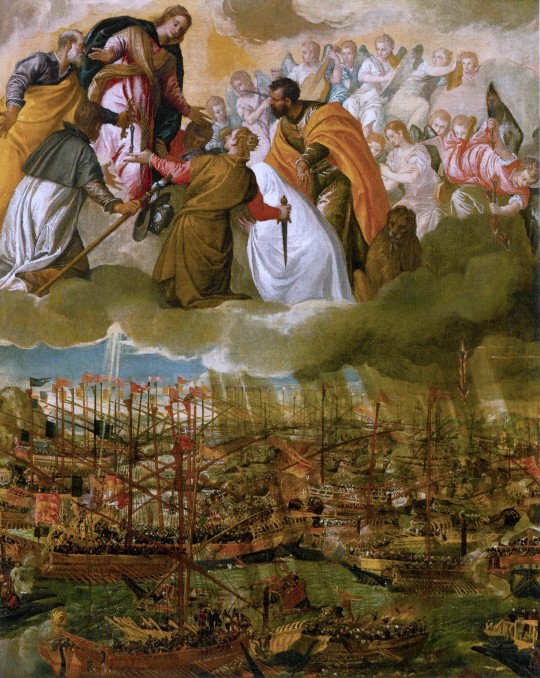
She's also the second biggest city of Aetolia-Acarnania after Agrinio.
That's all I have to offer. Have a good day (or night depending on what time exactly you're reading this post) 😘. The next post is gonna be the last about the Aetolia-Acarnanian Gang!
Sources:
A small part where I list all the sources of my information:
For Aetolia-Acarnania:
https://el.m.wikipedia.org/wiki/%CE%9D%CE%BF%CE%BC%CF%8C%CF%82_%CE%91%CE%B9%CF%84%CF%89%CE%BB%CE%BF%CE%B1%CE%BA%CE%B1%CF%81%CE%BD%CE%B1%CE%BD%CE%AF%CE%B1%CF%82
https://el.m.wikipedia.org/wiki/%CE%99%CF%83%CF%84%CE%BF%CF%81%CE%AF%CE%B1_%CF%84%CE%B7%CF%82_%CE%91%CE%B9%CF%84%CF%89%CE%BB%CE%AF%CE%B1%CF%82
https://el.m.wikipedia.org/wiki/%CE%99%CF%83%CF%84%CE%BF%CF%81%CE%AF%CE%B1_%CF%84%CE%B7%CF%82_%CE%91%CE%BA%CE%B1%CF%81%CE%BD%CE%B1%CE%BD%CE%AF%CE%B1%CF%82
https://en.m.wikipedia.org/wiki/Aetolia-Acarnania
https://en.m.wikipedia.org/wiki/Aetolia
https://en.m.wikipedia.org/wiki/Aetolian_League
https://en.m.wikipedia.org/wiki/Acarnania
For Messolonghi:
https://en.m.wikipedia.org/wiki/Missolonghi
https://en.m.wikipedia.org/wiki/Third_siege_of_Missolonghi
https://en.m.wikipedia.org/wiki/First_siege_of_Missolonghi
https://en.m.wikipedia.org/wiki/Second_siege_of_Missolonghi
https://el.m.wikipedia.org/wiki/%CE%9C%CE%B5%CF%83%CE%BF%CE%BB%CF%8C%CE%B3%CE%B3%CE%B9
https://el.m.wikipedia.org/wiki/%CE%88%CE%BE%CE%BF%CE%B4%CE%BF%CF%82_%CF%84%CE%BF%CF%85_%CE%9C%CE%B5%CF%83%CE%BF%CE%BB%CE%BF%CE%B3%CE%B3%CE%AF%CE%BF%CF%85
For Agrinio:
https://el.m.wikipedia.org/wiki/%CE%91%CE%B3%CF%81%CE%AF%CE%BD%CE%B9%CE%BF
https://en.m.wikipedia.org/wiki/Agrinio
For Astakos:
https://en.m.wikipedia.org/wiki/Astakos
https://el.m.wikipedia.org/wiki/%CE%91%CF%83%CF%84%CE%B1%CE%BA%CF%8C%CF%82_%CE%91%CE%B9%CF%84%CF%89%CE%BB%CE%BF%CE%B1%CE%BA%CE%B1%CF%81%CE%BD%CE%B1%CE%BD%CE%AF%CE%B1%CF%82
For Nafpaktos:
https://el.m.wikipedia.org/wiki/%CE%9D%CE%B1%CF%8D%CF%80%CE%B1%CE%BA%CF%84%CE%BF%CF%82
https://en.m.wikipedia.org/wiki/Nafpaktos
https://en.m.wikipedia.org/wiki/Battle_of_Lepanto
https://iaitoloakarnania.gr/2020/04/to-agalma-toy-thervantes-sti-naypakto-o-don-kichotis-kai-i-schesi-toy-me-tin-ellada/
#aph oc#aph: Messolonghi#aph: Missolonghi#hws Messolonghi#hws Missolonghi#aph ocs#aph: Agrinio#hws Agrinio#aph: Astakos#hws Astakos#aph: Nafpaktos#hws Nafpaktos#aata#athens and thessaloniki adventures
4 notes
·
View notes
Text
Note: The characters presented there are inspired by @allbeendonebefore's work and has no intention to mock you, rather to entertain you. Without further ado, let's move on.
In case you don't know, I love drawing and making headcanons about the personifications of modern greek cities and towns for various reasons, mainly because I want to promote the modern image of my country, as opposed to the ancient one that most foreigners are familiar with.
This time, I made 10 personifications, the two of them representing a regional unit (I will explain later why it's two and not one) and the rest representing some towns of that regional unit.
The regional unit, in question, is:

So, why Aetolia-Acarnania of all regions? Well, partly because my mom is from there and because almost nobody on the internet talks about it, so I wanted to make it more well-known.
I tried to seach some information online and I couldn't find much, other than that the Ancient Greeks considered these people barbarians, because they were war-like and didn't produce works of art.
Anyways…
Artistic choices: Aetolia and Acarnania's appearances were based from my uncles'. Specifically, Acarnania looks exactly like the one I based him from. Aetolia not do much, except from the face. None of my uncles have shoulder-length hair, I just added it to give him a more savage look based on the idea that the Ancient Greeks had about these people (which still exists today, but we will discuss it later). It was kinda difficult, because I'm not used on drawing male characters and even when I do, I give them a "cute-boy" look, so it was challenging but nice to draw something different for once. Also, regarding the choice of the color. I thought of all the colours that Hapo used in her @athensandspartaadventures: green, red, lots of purple and a little bit of brown. I wanted to choose a colour that she hasn't utilised and the first one to come to my mind was mustard yellow. Sooner or later, I will come up with an actual good explanation (or I might use a different colour).
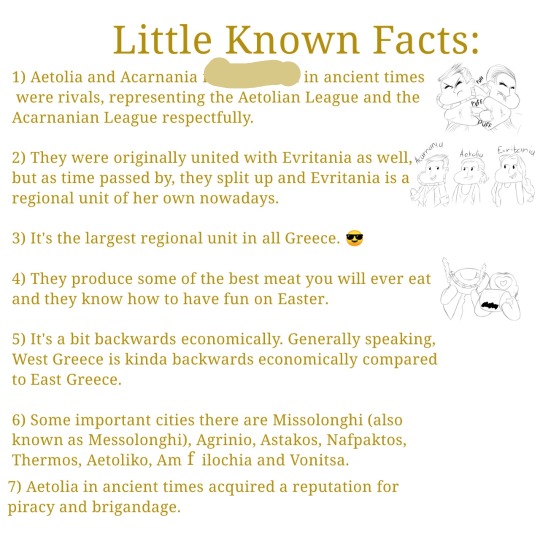
Now, enjoy some photos I took while I was on vacation.
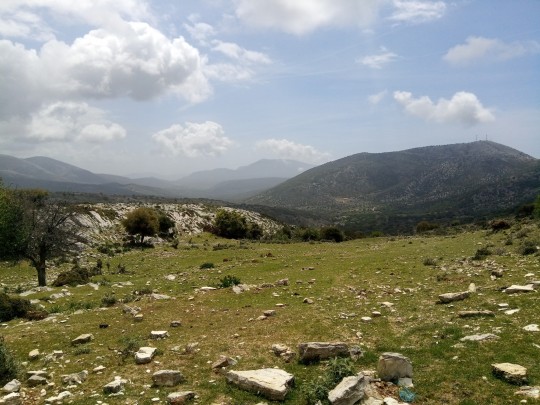
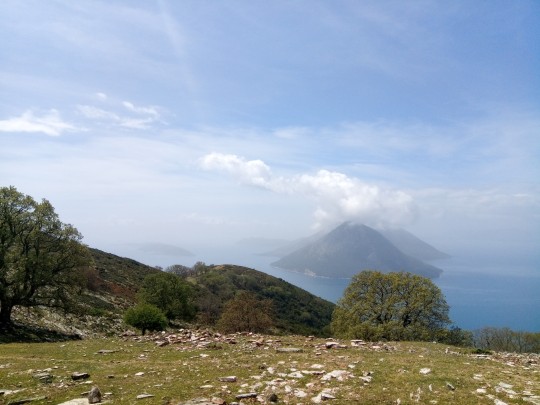

The view from above the mountains.
Honestly, the trip there feels like visiting South France, since it's full of green. A small tip for all the foreigners who are in Greece right now, but they wish they were in South France: just visit Aetolia-Acarnania! It's the same thing! But better! 🙃
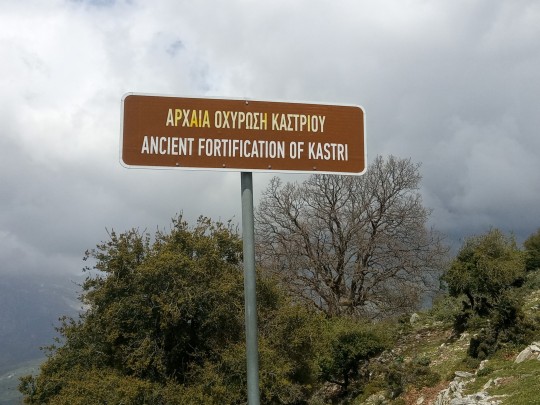


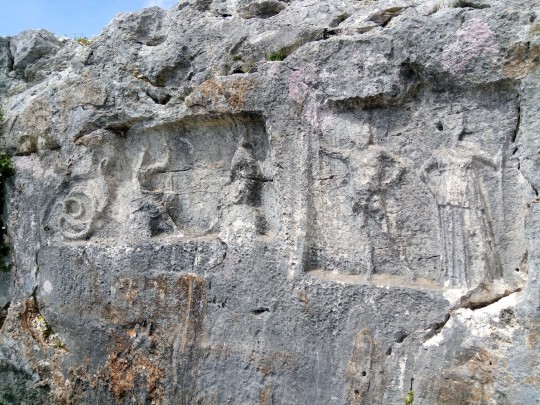
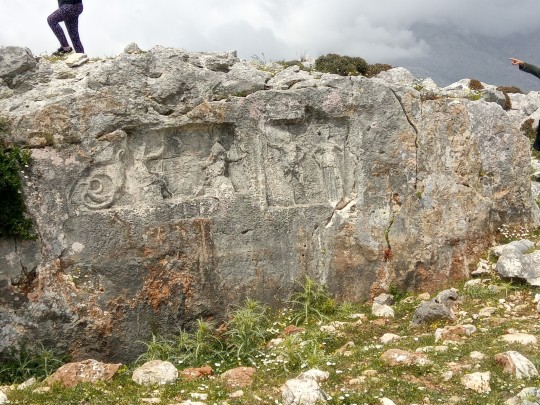
The Ancient Fortification of Kastri.
An ancient site I wish more people would visit. Mainly because I love the way we get there. Basically, you climb a mountain. All alone. Without a special equipment. But that's the fun of the ride! 😃
I telling you, you won't regret this!
I would really love to introduce some new characters, like Messolonghi or Agrinio, but unfortunately, Tumblr doesn't let me include more than 10 pictures. So, enjoy Aetolia and Acarnania and you might get to meet new characters in the upcoming week.
Bye and have a lovely day or night depending on when you're reading this post! 😘
#aph:aetolia#aph:acarnania#aph:aetolia-acarnania#hws aetolia#hws acarnania#hws aetolia-acarnania#aata#athens and thessaloniki adventures#kastri#Aetolia-Acarnania
4 notes
·
View notes
Text
Click here to see the first part.
Note: the series was inspired by @athensandspartaadventures by Hapo (@allbeendonebefore) and has no intention to insult you, rather to entertain you. Without further ado, enjoy!
Welcome to the second part of "Linguistic differences between Athens and Thessaloniki" (the link for the first part can be found above), a sub-series of "Athens and Thessaloniki Adventures", which attempts (but fails) to explain to non-Greeks how things run in Modern Greece (because you know, it's not just Ancient Greece, we still exist, damn it!).
I originally wanted to draw this post in digital art and then turn it into a gif, but after four tries, I was frustrated about the result and I decided to do it in the old traditional way that I'm more familiar. And to be honest, I'm glad how it turned out.
And, as you probably gonna find out, I'm still looking for my art style. Guess I'll have to wait to get my own digital pen and tablet, instead of doing it with my finger on the phone.

Today's topic is about the infamous "me/mou" and "se/sou" debate (which in English roughly translates to "me" and "you" respectfully) and the less infamous but still prominent "tou/ton" and "tis/tin" (which in English roughly translates to "him" and "her" respectfully).
ATHENS
Let's start with the capital. The Athenians (and generally, the South Greeks) use "mou", "sou" and "tou/tis" where the Thessalonians (and generally, the North Greeks) would use "me", "se" and "ton/tin" respectfully.
Examples include:

Translation:
First bubble (first row on the left): "Με πήρες τηλέφωνο" - "Me pires tilephono" - "You called me on the phone"
Second bubble (first raw on the right): "Μου πήρες τηλέφωνο" - "Mou pires tilephono" - "You got me a phone"
Third bubble (second row on the left): "Άνοιξέ μου από πίσω" - "Anoixe mou apo piso" - "Open for me from behind"
Fourth bubble (second raw on the right): "Άνοιξέ με από πίσω" - "Anoixe me apo piso" - "Open me from behind"
Fifth bubble (third row on the left): "Πλάκα ΜΟΥ κάνεις;! […] ΣΟΥ λέω!" - "Plaka MOU kaneis?! […] SOU leo!" - "Are you kidding ME? […] I'm telling YOU!"
Sixth bubble (third row on the right): "Του/της είπες…;" - "Tou/tis eipes…?" - "Did you tell him/her…?"
Introducing Attika (with a "k", instead of the anglo-saxon "c") aka fem!Athens and Athens' wife in the original comic. I'm would really love to introduce more characters as well, but I don't think I'm gonna do it with Ionia, since she's part of Turkey nowadays and our relations with that country aren't exactly… nice and I don't want to explain further…
And it really saddens me, because she was adorable! 😢
As for Modern Corinth, Sparta and Thebes, I don't think they're gonna make many appearances as they don't have that much influence today (which is a shame, because I really liked Corinth) and because the "Big Ones" now are Athens, Thessaloniki, Piraeus, Crete and Patras.
I'm not sure if I should introduce a male! Thessaloniki, as the region where the city is located is also called Thessaloniki and it will sound confusing to readers.
Moving on…
THESSALONIKI
Now it's the time for the co-capital. The Thessalonians (and generally, the North Greeks) use "me", "se" and "ton/tin" where the Athenians (and generally, the South Greeks) would use "mou", "sou" and "tou/tis" respectfully.
Examples include:

Translation:
First bubble (first row on the right): "Με πήρες τηλλέφωνο" - "Me pires tilllephono" - "You got me a phone/ You called me on the phone"
Second bubble (first row on the left): "Άνοιξε με από πίσω" - "Anoixe me apo piso" - "Open for me from behind"
Third bubble (second row): "Πλλάκα ΜΕ κάνεις;! […] ΣΕ λλέω! Τον/την είπες;" - "Pllaka ME kaneis?! […] SE lleo! Ton/tin eipes?" - "Are you kidding ME?! […] I'm telllling YOU! Did you tellll him/her?"
Now, a philologist or anyone who has studied ancient greek will say that the me/se/ton/tin is the right form, despite the mou/sou/tou/tis being far more popular and used more often in greek media. And it's true. I will still use mou/sou/tou/tis, however. Because I'm South Greek. But mainly, because I'm an awful person 😈. Same goes with "kalamaki".
If I was wrong about something or confused you, plz tell me and I will keep that in my mind or help you.
Thanks for reading my post and have a lovely day (or a lovely night). Bye! 😘
#my art#randomthingsandstuffs#art#aph oc#aph: athens#aph: thessaloniki#athens and thessaloniki adventures#hws athens#hws thessaloniki#aph athens#aph thessaloniki
9 notes
·
View notes
Text
Note from the author: Before you read this blog, I have to tell that I don't want to insult anyone. This comic was created for fun and it just wants to entertain you. You can always tell me if you ever feel insulted. Enjoy!
Big inspiration from @allbeendonebefore. The designs for both Athens and Thessaloniki were based from her work!
Ok, so a few months ago, I created something like a poster for an upcoming comic series (that wouldn't come any sooner) called "Athens and Thessaloniki Adventures" (I would recommend you not to check it out, since it's really poorly drawn), which was inspired by Hapo's @athensandspartaadventures.
Anyway, I decided to make a small comic strip regarding some linguistic differences between these two cities, because even though they both belong in the same country, they still have many differences.
The art style is simple and it doesn't have that much of details, but I think it suits this more, since these city personifications are based from generic stereotypes that we modern Greeks hold about the residents of said cities.
Lastly, I wanted to give Thessaloniki a more extravagant look (Thessalonian women are famous for dressing like this even when they only go out for about five minutes) but I don't think I did a good job. So… uhm… I'm sorry, I guess! She also pronounces intensely the "ll".
Without further ado, enjoy! ☺️








Note: So, guys, do you know about this delicious traditional greek food:

Well, the Athenians (and generally, the South Greeks) call it "kalamaki", while the Thessalonians (and generally, the North Greeks) call it "souvlaki". However, "kalamaki" also means "straw" in greek and you can understand how confusing and silly this sounds to the Thessalonians.
If you ask any Athenian on why they call it like this, they will tell you because they're used to it and because the wooden stick that they use to impale the meat is made by a plant named "kalami" (literally, "common reed"). Kalami->Kalamaki.
Meanwhile, if you ask the Thessalonians the same question, they'll tell you because they're used to it (again) and because "souvlaki" derives from the verb "souvlizo" (literally, "impale"). Souvlizo->Souvlaki.
Choose which meaning you believe is correct.
Also, the Athenians call every yellow cheese either "cheese" or with its name (ex. "cheddar", "gouda", "parmesan" etc), while the Thessalonians call every yellow cheese "cheddar".
Again… choose which meaning you believe is correct.
Bye and have a lovely day (or a lovely night)! 😘
#aph: athens#aph: thessaloniki#hws athens#hws thessaloniki#allbeendonebefore#athens and thessaloniki adventures#athens#thessaloniki#shitpost#greek shitpost#kalamaki#souvlaki#art#my art
9 notes
·
View notes
Text
Note: the series was inspired by @athensandspartaadventures by Hapo (@allbeendonebefore ) and has no intention to insult you, rather to entertain you. Without further ado, enjoy!
Big inspiration from @allbeendonebefore . The design for Sparta was based from her work.
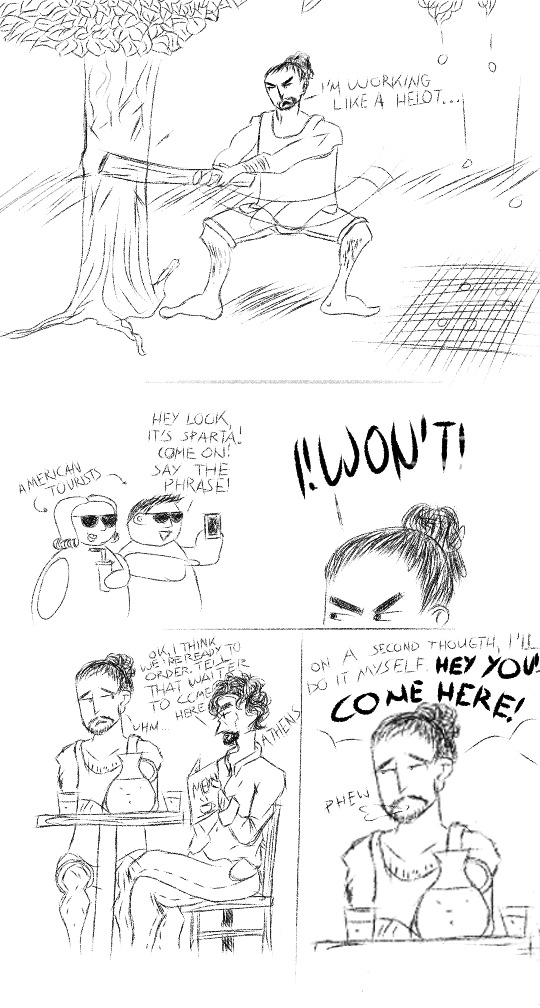
After a long, LONG time, I finally figured a way to present Modern Sparta. To be honest, I had such a hard time, mainly because Modern Sparta is such an obscure town in Greece. No kidding! For a town that had such an influence on Ancient Greece, almost no body talks about its modern incarnation and it's ALWAYS about the ancient city.
Ok, maybe I'm wrong. There was a time that Modern Sparta was indeed talked, but that was because of all the weird shits that happened in its City Councils and it was popular to make fun of the Spartans because of that (one thing that you should understand about as Greeks is that we don't uplift each other and whenever we have the chance, we will make fun of each other). Not helped by the fact that for many Greeks outside of the Peloponnese, this was the first time they heard about Sparta after the Peloponnesian War and… it didn't have a good image on their heads. Then, the City Counsils stopped being interesting and Sparta faded into obscurity once again. So, in few words, that's the image that the majority of Greeks have about this town.
Then, I became friends with a girl from Laconia and she told me some things about Sparta. Here are some notes:
The Spartans are extremely tall [ironically, she's short (for their standards, for our standards, she's considered of average height)]
They're also extremely laconic (ironically, her twin brother is extremely talkative and he feels out of place there for that reason)
They're just introverts who need an extrovert to do all the talking for them
Now, that we've got that covered, let's move on some notes of this comic.
The upper image depicts Sparta hitting an olive tree to make the olives fall. Mani, which is in Laconia, is famous for its olive oil production. He says "I'm working like a helot".
"I'm working like a helot" is a phrase that we Greeks use when we overwork ourselves ("wHaT?!" a Northern European might wonder. "GrEEks oVeRWorkInG thEmSElves To DeaTh?! tHaT's ImPOssibLe! ThEy'rE lAzY!"). It's derived (if what I know is correct) from the slaves of Ancient Sparta, the Helots, who were said to work on harsh and brutal conditions. I was torn between having either Messene (Mr. Helot, in the original comic) or Sparta to say that, but I decided with the latter, since it would be funnier because… irony.
The American tourists in the middle image are, of course, refering to "This! Is! Sparta!" meme from 300.
That's all I have to offer. Have a good day (or night depending on what time exactly you're reading this post) 😘
#aasa#aata#athens and sparta adventures#athens and thessaloniki adventures#aasa sparta#aata sparta#aph sparta#hws sparta
3 notes
·
View notes
Text
Note: the series was inspired by @athensandspartaadventures by Hapo (@allbeendonebefore ) and has no intention to insult you, rather to entertain you. Without further ado, enjoy!
Big inspiration from @allbeendonebefore. The design for Ionia/Miletus was based from her work.
Ok, let's get down to business 🎶to defeat the Huns.🎶 Two months ago, a greek movie called "Smyrni mou agapimeni" (english translation: "Smyrna, my beloved") circulated in theatres and it had to do with (as you probably have guessed) the great catastrophe of Smyrna back in 1922.
As someone who lives in a town that was founded by immigrants from Asia Minor and since a century has passed from that event, I was intrigued and I immediately started a draft, but due to exams, I didn't finished it until much later.
Inspired by this, I took Hapo's character, Ionia/Miletus and had her star in the poster of the movie. And yes, I know that Ionia is the personification of Miletus, but technically speaking, Miletus is located in Asia Minor, so it makes sense.

We will start first with a historical note to help foreigns understand. I should advise you that I'm no historian, so it's gonna be oversimplified and it would be much more preferable to search the Internet. Here are some links: link 1, link 2. And as always, you can help me add more stuff or correct me for the things I was wrong.
It all started way back in the 19th century, after Greece was freed from the Ottoman Empire. Back then, a plan named "Great Idea" was formed, where we would try to retrieve the terrains that were originally inhabited by Ancient Greeks (namely, South Balkan and Ionia).
This "Great Idea" was finally realised in 1919, with the help of Eleftherios Venizelos and of Entente. At first, the Greek army came victorious and we penetrated even further to the Turkish land.
So, what went wrong? Well, in 1920 Venizelos loses the elections and King Constantine comes to power. This disgruntled many army officers in Asia Minor who were in favour of Venizelos, as well as with the Entente, who never really liked Constantine (since Constantine didn't hide his admiration for Germany's militaristic discipline). All this, combined with the rise of Mustafa Kemal turned the tides in favor of the Turkish army and the Greek army started to back off.
The saddest moment has to be the catastrophe of Smyrna. Smyrna for Greeks was an important city, as the Greek spirit/element was prominent there (more than half of its inhabitants were Greeks). The Smyrnians, as well as other Greeks from Asia Minor, came to mainland Greece as immigrants, desperately looking for a new home and support…
Now, on an critical note: while I don't hate this piece, I don't think that it's one of my best works either. I would prefer a font that it's exactly like the one of the poster, but I couldn't find it on ibis paint. In case you're wondering, this is the poster:

Also, in case you're wondering, NO, we don't want to retrieve Asia Minor anymore. We're passed that.
Next time on the unofficial sequel of AaSA: I finally figured out what to do with Modern Sparta :)
#athens and sparta adventures#athens and thessaloniki adventures#aasa ionia#aasa miletus#aata ionia#aata miletus#aph oc#aph: ionia#aph: miletus#hws ionia#hws miletus#aasa#aata#allbeendonebefore
4 notes
·
View notes
Text
Click fore better quality!
Note: the series was inspired by @athensandspartaadventures by Hapo (@allbeendonebefore ) and has no intention to insult you, rather to entertain you. Without further ado, enjoy!
Big inspiration from @allbeendonebefore . The designs for Corinth based from her work!


So, a few notes to better understand the humor in this page:
Euro (€) is the currency we use. For non-European readers (and Europeans who belong in the European Union, but don't use €), 1€ = 1,08$.
Quite many Greek series and movies often depict us Greeks selling souvenirs to foreign tourists (we understand they're not from Greece from the fact they speak English) in a ridiculous high price. The reason for that, you may ask? Well, foreign tourists (especially the ones from North Europe and North America) are rich and we Greeks are currently dealing with an economic crisis, so we need their money. If you want a lower price, show some respect for Greek culture, maybe try to say a few Greek sentences (in Modern Greek, not Ancient, there's a key difference). It will still be a bit expensive, but not that expensive. And if you want that souvenir in it's original price, try becoming friends with the shop owner. Once they like you, they'll be open towards you (thankfully, we Greeks pride ourselves as being warm and friendly people and we strive to live to that positive stereotype).
For @athensandspartaadventures readers, I imagine Corinth still being into a merchant job or something, so that's why I had her working as a shop runner.
If I was wrong about something or confused you, plz tell me and I will keep that in my mind or help you.
Thanks for reading my post and have a lovely day (or a lovely night). Bye! 😘
#athens and thessaloniki adventures#aata#aph oc#aph: corinth#aph corinth#aasa corinth#aata corinth#allbeendonebefore#randomthingsandstuffs#hws corinth
4 notes
·
View notes